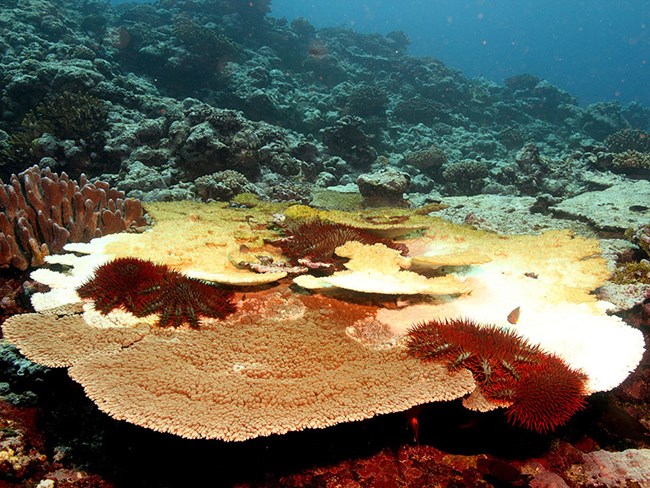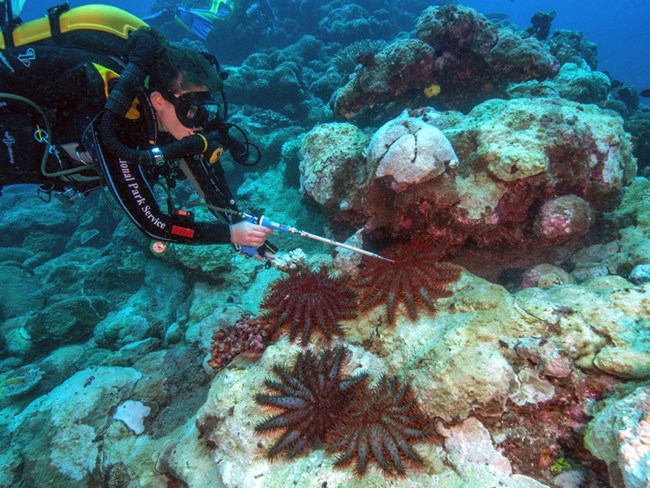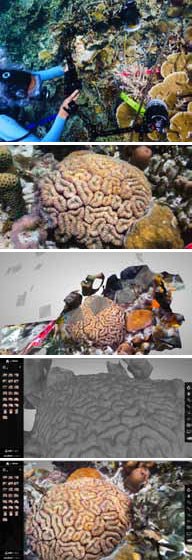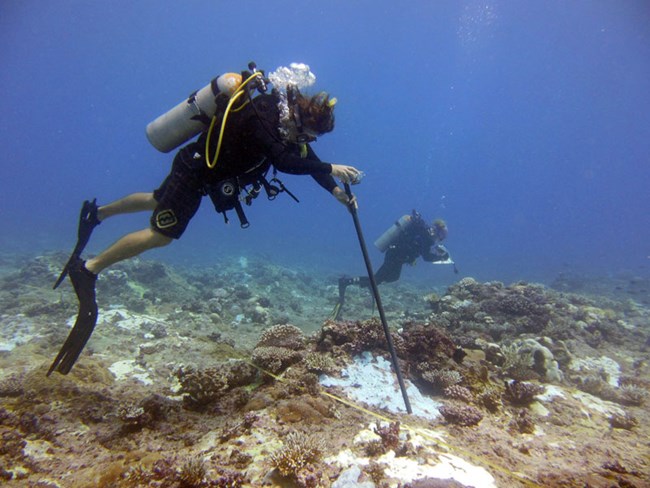Part of a series of articles titled Pacific Ocean Education Team (POET) Newsletters.
Previous: POET Newsletter May 2014
Article

NPS / Dr. Ben Becker
Since the summer of 2013, visitors to Point Reyes' rocky shores have been asking park staff, "Where are all the starfish?" The answer is Sea Star Wasting Disease, caused by an as yet unidentified pathogen that is decimating sea star populations along the west coast of the US and British Columbia, including NPS units at Cabrillo, Golden Gate, Point Reyes, Redwood, and Olympic. This almost complete absence of "sea stars" (the proper term) mirrors a pattern along the rocky intertidal coastline from Southern California to British Columbia. The nature of the pathogen is currently unknown, although the latest research suggests that the stars may be getting the disease from their prey, since sea stars housed in experimental tanks with mussels collected from the wild get sick, while those in tanks with mussels grown in captivity stay healthy. Similar outbreaks occurred in the wild in the 1970s, 1980s, and 1990s, but these were much more limited in geographic scale and sea star populations recovered in a few years. However, marine biologists consider the speed, range, and lethality of this outbreak as unprecedented.
What does the disease and the loss of sea stars mean for the rocky intertidal? The two primary sea stars affected, the purple or orange Ochre Sea Star (commonly seen all along rocky shores of the Northeast Pacific) and the deeper water Sun Star (pictured above) are both top predators. They eat mussels and many other intertidal organisms, and therefore exert what ecologists call a strong predatory top-down effect on the rocky shore ecosystem. Ecologists predict that the loss of these predators could lead to big changes in the appearance and species composition of rocky shores, especially if the sea stars are gone for a long time, or even permanently.
Researchers at UC-Santa Cruz are coordinating efforts to both track the spread and hopefully a recovery from the disease. There are a few glimmers of hope that may be testament to the resilience of nature. For example, while monitoring sites at Point Reyes and Golden Gate this summer showed precipitous declines in sea star counts, one site still had very good recruitment of young ochre sea stars, giving some hope that the population may eventually to recover. However, only time will tell if there will be a rapid, slow, or no recovery, and what changes we may or may not see in the ecosystem.
For more information and the latest updates, go to: seastarwasting.org

NPS
Found throughout the Indo-Pacific the crown of thorns starfish, Acanthaster planci is one of the largest sea stars in the world (up to 45 cm across). Unlike the typical starfish with five arms, the crown of thorns starfish is disc-shaped with multiple arms (up to 21) covered in poisonous spines. These unique features gave rise to this starfish's commonly referred to name of the crown of thorns.
Acanthaster planci is a corallivore, which means that it feeds on live coral tissue. After climbing on a coral colony, the crown of thorns starfish extrudes its stomach out through its mouth and spreads it over the surface of the corals. The stomach secretes digestive enzymes that liquefy the coral tissue which is then absorbed. After this process, the coral colony is left devoid of living tissue and only the white skeletons of the colony remain. On the skeletons, the starfish leave behind observable feeding scars which mark the paths of their destruction. Without the living tissue, the skeletons become more vulnerable and brittle, and are often colonized by non-reef building organism such as algae.
Known as voracious predators, a single crown of thorns starfish can consume approximately 6–10 square meters of living reef per year. Low densities of Acanthaster planci naturally occur on reefs with little impact to the ecosystem. However, under certain conditions periodic population explosions of these starfish can occur on reefs, generating alarm due to the extensive damage they can unleash to the corals and the reef ecosystem.

NPS
Acanthaster planci has been documented as moving up to 35 cm/minute, thus in short period of time a large amount of damage can be done. Envision a dinner plate size worth of damage to the reef by each starfish each day.
A study in the Central Great Barrier Reef region documented large crown of thorns starfish (40 cm and greater) decimating live coral at a rate of 161 cm²/day in winter and 357–478 cm²/day in summer.
In addition to being a fast eater, the crown of thorns starfish can also be a picky one, having innate preferences for certain coral species over others. Corals species from the genera Acropora and Pocillopora are their preferred foods. Controlled laboratory studies have shown preferences even within the genus Acropora with the most preferred species being Acropora hyacinthus, followed by A. gemmifera, A. nasuta, and A. formosa. However, when food becomes limited, the crown of thorns starfish is known to eat all species of hard coral, and then start eating the soft corals.

NPS
Unfortunately, the National Park of American Samoa (NPSA) is experiencing an ongoing outbreak of this hungry corallivore. Luckily, the park and the Pacific Island Network Inventory & Monitoring Program (I&M) have been monitoring the benthic marine community in NPSA as a "Vital Sign" since 2007. Site specific reef data on the coral species are included as a part of the benthic marine community monitoring protocol. By knowing which reefs have the crown of thorn's preferred food species (e.g., species from the genera Acropora and Pocillopora), park managers can better identify reef sites for culling and removal of this starfish. Geo-referenced maps of monitored reefs showing coral cover and species were rapidly provided by I&M to NPSA to help the park prioritize their efforts (see photo caption below).
Marine Ecologist, Dr. Tim Clark, has estimated that 6,433 crown of thorns starfish have already been removed from several sites across Tutuila Island. But there is much work left to do.
This is an excellent example of employing long-term monitoring data to inform efficient management action for one of our most precious natural resources.
– Sheila A. McKenna, NPS Marine Biologist, 2014
Corals cover less than 0.1% of the ocean floor, yet contain levels of biodiversity that rival the rainforest. Coral reefs support multi-million dollar fishing and tourist industries in Hawai’i, provide coastline protection from storms and typhoons, shelter countless organisms, and are the life-line for many families that rely directly on the ocean for sustenance. Worldwide, coral reefs are facing an ever-increasing number of natural and human-induced threats including: pollution, increasing sea-surface temperatures, over-fishing and destructive fishing practices, increasing disease occurrence, and ocean acidification.
Despite their crucial role, coral reef research and education are still in their infancy. Astonishingly, there are no reliable and cost effective methods of determining coral growth, a basic and essential parameter for understanding the health of a coral reef ecosystem. Furthermore, corals exist in three-dimensional (3D) space, and current methods of measuring coral growth rely on two-dimensional (2D) measurements.
Most corals are inaccessible to anyone who does not SCUBA dive, especially children. Until now, the only way to visualize corals has been to view static pictures or non-interactive films. As a result, public interest in the complexities of coral reefs pales in comparison to other charismatic megafauna such as sharks, whales and dolphins. We must continue to find ways to stimulate coral reef education.

Step 1. Multiple pictures are taken around a coral head. The more complex the coral, the more pictures required. Proficient experience in SCUBA diving, underwater photography, and the software are required. Previous 3D modeling methods would require much more equipment including LIDAR (Laser Depth and Range), which is incredibly costly; this method only requires a camera.
Step 2. Individual Images are edited to optimize processing by the modeling software. Elements such as temperature, contrast, exposure, and saturation are adjusted.
Step 3. Images are imported into the software. Grey rectangles in this figure show where each image was taken in 3D space relative to the subject being modeled. The software automatically calculates the vantage point of each photo. It takes 1-2 hours to generate a model, which is superior to previous 3D model rendering methods, which required days to weeks.
Step 4. The software creates a mesh composed of hundreds of thousands to millions of mesh triangles. Previous 3D modeling software could only produce models with resolutions of a few thousand mesh triangles.
Step 5. Models are further post-processed through 3D editing software. The final product is an ultra-high resolution, true-color interactive 3D model. In previous methods, the entire process from photographing features to producing a 3D model took days to months. In this new method, the entire process can be completed in a few hours. You can visit this interactive model at http://thehydro.us/coral-in-3d/

© D. Burdick
In response to stresses such as higher water temperatures, corals can lose the symbiotic microscopic algae (which provides up to 95% of the coral's nutrition) from their tissues causing them to look white or "bleached." If favorable conditions return, corals can sometimes recover. However, bleached corals are more vulnerable to disease and other stressors, which can lead to death. This worldwide trend of coral bleaching is linked to global warming.
Coral reefs contain some of the most diverse ecosystems in the world and serve as critical habitats for thousands of species of marine organisms. Reefs support fisheries, protect coastlines from storms, and provide recreation. Coral bleaching resulting from higher sea surface temperatures threatens these re-sources. In 2013, an unprecedented coral bleaching event across Guam and the Marianas Archipelago was correlated with increased sea surface temperatures and reduced wind speeds for a four-month period. As a result, an astounding 85% of coral taxa showed signs of bleaching. This major event prompted the Guam Long-term Coral Reef Monitoring Program, NOAA, Guam EPA, the National Park Service, University of Guam, and Guam DAWR to work together to investigate the issue in an effort to promote coral reef resilience and recovery after such events.
Monitoring the coral reefs is a major activity of the National Park Service Pacific Island Inventory & Monitoring Network. National parks are partnering with research organizations like the University of Guam to study the impacts of bleaching on Guam's coral reefs.
Scientists from many stakeholder organizations began formal quantitative assessments of 3,600 photos from 48 reef sites on Guam.
Dr. Ben Becker, Ph.D., Point Reyes National Seashore
Sylvester Lee, Kalaupapa National Historical Park
Sheila A. McKenna, National Park of American Samoa
Cory Nash, Pacific Island Network Inventory & Monitoring, NPS
John Dell'Osso, Point Reyes National Seashore
Part of a series of articles titled Pacific Ocean Education Team (POET) Newsletters.
Previous: POET Newsletter May 2014
Last updated: October 8, 2021